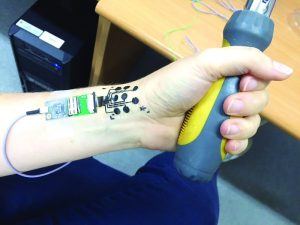×


We have detected your country as:
Please click here to go to the USA website or select another country from the dropdown list.

Photo courtesy: Tel Aviv University
Many of us are familiar with the somewhat unpleasant medical procedure of electromyography—recording electrical signals through the skin. A novel skin electrode, recently developed at Tel Aviv University’s [TAU’s] Center for Nanoscience & Nanotechnology, now takes this procedure out of the laboratory, doing away with the cold, sticky gel used to enhance conductivity. The friendly new electrode is comfortable and accessible, allowing users to carry on as usual with their daily routines, while monitoring their muscle activity for many hours for a range of medical and other purposes.
One major application of the new electrode may be the mapping of emotions. Prof. Hanein says, “Advertisers, pollsters, media professionals and others—all want to test people’s reactions. Today, with no accurate scientific tools available, they rely mostly on inevitably subjective questionnaires. Our skin electrode provides a simple, convenient solution: monitoring expressions and emotions based on the electric signals received from facial muscles.”
According to Prof. Hanein, the new skin electrode has many more potential applications: a study initiated recently in collaboration with researchers at the Tel Aviv Medical Center uses it to monitor the muscle activity of patients with neurodegenerative diseases; physiological data measured in specific muscles may be used in the future to indicate the alertness of drivers on the road; patients in rehabilitation following stroke or brain injury may utilize the “tattoo” to improve muscle control; and amputees may employ it to move artificial limbs with remaining muscles.
The highly promising new skin electrode is based on a surprising fusion of nanotechnology with a very basic and commonplace product: the temporary tattoos that children love so much. “We used readily available materials and conventional industrial printing techniques,” says Prof. Hanein. “Our ‘electric tattoo’ consists of three parts: a carbon electrode, an adhesive surface that sticks temporary tattoos to the skin and a nanotechnology-based conductive polymer coating, with special nano-topography, that enhances the electrode’s performance. The result is an efficient skin electrode that records a strong and steady signal for many hours, and does not irritate the skin.”
Source: Excerpt of article by TAU Spokesperson, Israel Ministry of Foreign Affairs
All logos and trademarks in this site are property of their respective owner. All other materials are property of Bridges for Peace. Copyright © 2024.
Website Site Design by J-Town Internet Services Ltd. - Based in Jerusalem and Serving the World.